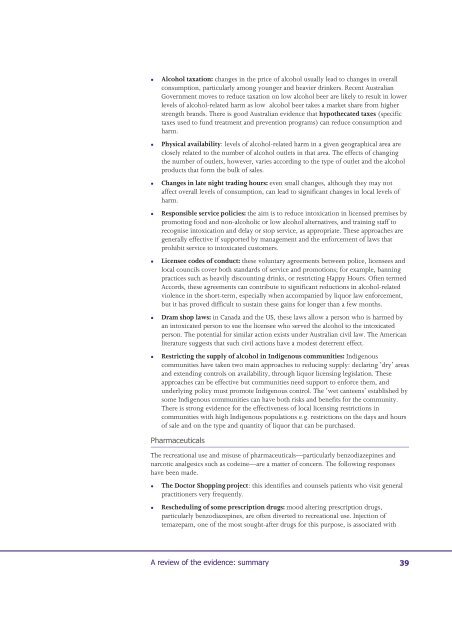Summary - Department of Health and Ageing
Summary - Department of Health and Ageing
Summary - Department of Health and Ageing
You also want an ePaper? Increase the reach of your titles
YUMPU automatically turns print PDFs into web optimized ePapers that Google loves.
Alcohol taxation: changes in the price <strong>of</strong> alcohol usually lead to changes in overall<br />
consumption, particularly among younger <strong>and</strong> heavier drinkers. Recent Australian<br />
Government moves to reduce taxation on low alcohol beer are likely to result in lower<br />
levels <strong>of</strong> alcohol-related harm as low alcohol beer takes a market share from higher<br />
strength br<strong>and</strong>s. There is good Australian evidence that hypothecated taxes (specific<br />
taxes used to fund treatment <strong>and</strong> prevention programs) can reduce consumption <strong>and</strong><br />
harm.<br />
Physical availability: levels <strong>of</strong> alcohol-related harm in a given geographical area are<br />
closely related to the number <strong>of</strong> alcohol outlets in that area. The effects <strong>of</strong> changing<br />
the number <strong>of</strong> outlets, however, varies according to the type <strong>of</strong> outlet <strong>and</strong> the alcohol<br />
products that form the bulk <strong>of</strong> sales.<br />
Changes in late night trading hours: even small changes, although they may not<br />
affect overall levels <strong>of</strong> consumption, can lead to significant changes in local levels <strong>of</strong><br />
harm.<br />
Responsible service policies: the aim is to reduce intoxication in licensed premises by<br />
promoting food <strong>and</strong> non-alcoholic or low alcohol alternatives, <strong>and</strong> training staff to<br />
recognise intoxication <strong>and</strong> delay or stop service, as appropriate. These approaches are<br />
generally effective if supported by management <strong>and</strong> the enforcement <strong>of</strong> laws that<br />
prohibit service to intoxicated customers.<br />
Licensee codes <strong>of</strong> conduct: these voluntary agreements between police, licensees <strong>and</strong><br />
local councils cover both st<strong>and</strong>ards <strong>of</strong> service <strong>and</strong> promotions; for example, banning<br />
practices such as heavily discounting drinks, or restricting Happy Hours. Often termed<br />
Accords, these agreements can contribute to significant reductions in alcohol-related<br />
violence in the short-term, especially when accompanied by liquor law enforcement,<br />
but it has proved difficult to sustain these gains for longer than a few months.<br />
Dram shop laws: in Canada <strong>and</strong> the US, these laws allow a person who is harmed by<br />
an intoxicated person to sue the licensee who served the alcohol to the intoxicated<br />
person. The potential for similar action exists under Australian civil law. The American<br />
literature suggests that such civil actions have a modest deterrent effect.<br />
Restricting the supply <strong>of</strong> alcohol in Indigenous communities: Indigenous<br />
communities have taken two main approaches to reducing supply: declaring ‘dry’ areas<br />
<strong>and</strong> extending controls on availability, through liquor licensing legislation. These<br />
approaches can be effective but communities need support to enforce them, <strong>and</strong><br />
underlying policy must promote Indigenous control. The ‘wet canteens’ established by<br />
some Indigenous communities can have both risks <strong>and</strong> benefits for the community.<br />
There is strong evidence for the effectiveness <strong>of</strong> local licensing restrictions in<br />
communities with high Indigenous populations e.g. restrictions on the days <strong>and</strong> hours<br />
<strong>of</strong> sale <strong>and</strong> on the type <strong>and</strong> quantity <strong>of</strong> liquor that can be purchased.<br />
<br />
The recreational use <strong>and</strong> misuse <strong>of</strong> pharmaceuticals—particularly benzodiazepines <strong>and</strong><br />
narcotic analgesics such as codeine—are a matter <strong>of</strong> concern. The following responses<br />
have been made.<br />
<br />
<br />
The Doctor Shopping project: this identifies <strong>and</strong> counsels patients who visit general<br />
practitioners very frequently.<br />
Rescheduling <strong>of</strong> some prescription drugs: mood altering prescription drugs,<br />
particularly benzodiazepines, are <strong>of</strong>ten diverted to recreational use. Injection <strong>of</strong><br />
temazepam, one <strong>of</strong> the most sought-after drugs for this purpose, is associated with

















